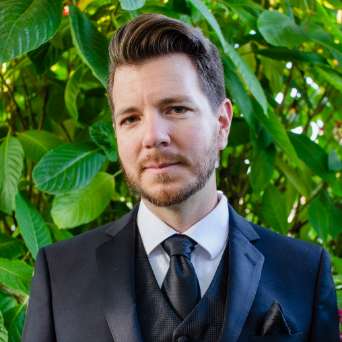An internationally acclaimed singer with a career spanning well over 30 years should be granted almost whatever role he’d like to do. It would also be understandable if the singer chose a well-known, crowd-pleasing piece, but, as is quite evident by now, Ferruccio Furlanetto is not a typical singer. The elder statesman of Italian basses, who has made Massenet’s Don Quichotte a staple of his repertoire, requested and received from San Diego Opera a new production of Ildebrando Pizzetti’s rarely performed Murder in the Cathedral (1958). The highly-anticipated opening Saturday night certainly didn’t disappoint thanks to a tour de force performance from Furlanetto and fine support from the rest of the company.
The opera world owes a debt of gratitude to Furlanetto, who essentially brought this piece back 10 years ago after decades of obscurity. Pizzetti’s opera is uniquely concise, with minimal dramatic action, but maximum dramatic anticipation. Including intermission, the evening was under two hours. The frenetic pace of the text, supported by Pizzetti’s atmospheric yet relentlessly driving score, made for a uniquely engaging piece of operatic theater. The through-composed score has virtually no repetition in it save a unique sort of ensemble mimicry in the groups of priests, tempters and knights. Just keeping up with the supertitles can be a bit of a workout.
Thankfully, the expert leadership at San Diego Opera created a straightforward but effective production by Ian Campbell. The sets essentially consisted of columns, a wide, short staircase, and realistic stained glass backdrops. Combined with appropriate religious props it made for a satisfying tableau. The lighting was unfussy, but significant in focusing the action.
Still, a piece like this could not succeed without an artist of Furlanetto’s magnitude. Thomas Becket, the legendary Archbishop of Canterbury, is on stage for virtually the entire evening. His music is not only musically challenging, running the entire range of the tessitura, but dramatically exhausting in its declamatory delivery. Furlanetto was supremely sympathetic as Becket. His nobility of stature and ease of delivery was convincing and especially devastating in his tragic demise. His gleaming bass voice, an especially noble instrument distinguished by his highly expressive delivery, was majestic in its sonority. Furlanetto oozed authority and regalness vocally, dramatically, and physically, yet also a passionate fevor. His confrontation with the four tempters in the first act was a dramatic dilemma reminiscent of King Philip’s third act in Verdi’s Don Carlo. Furlanetto portrayed Becket’s struggle as a multi-layered journey towards the ultimate choice of martyrdom as the only answer.
Furlanetto’s colleagues were no less committed or capable. Gregory Reinhart, Greg Fedderly, and Kristopher Irmiter were dramatically at ease as the three priests. Reinhart especially excelled with a sonorous bass voice. Tenor Allan Glassman was a spry herald. The Four Tempters/Knights received good-natured jeers as the opera’s villains at the curtain call, but their interactions as the knights were finely timed and well sung. Tenor Joel Sorensen had an exceptionally biting sound that he was able to parlay into sneering villainy. Veteran bass Kevin Langan was still in fine voice, and Malcom MacKenzie sang with a beguiling baritone sound. Ashraf Sewilam didn’t have as much heft as his counterparts but was still effective. The Knights’ post-assassination justification (think Don Giovanni postscript) was one of the more unique components of the piece and effectively performed. Susan Neves and Helene Schneiderman were both musically secure and vocally powerful.
Conductor Donato Renzetti led the forces confidently but with keen attention to the onstage performers. It was a driving but not overbearing performance. His familiarity with the score was a great asset as the orchestra delivered with impressive nuance and shading. The chorus, which had a monstrous part, sang beautifully. This was not easy music and there was a lot of it. The women’s chorus was onstage for almost the entire evening and their dramatic contribution to the action was significant.
Pizzetti’s opera contains some sublime music, particularly for the choruses, that materializes from the occasionally constricting score. It is creative and singular, worthy of further listening and study. It is not abrasive, nor lyrical; there are moments of Ravel, moments of Verdi, but never imitation. To say Furlanetto’s performance was remarkable would be an understatement. It was a high artistic achievement, a sort of culmination of all that can be inspiring in great opera. San Diego Opera’s high standards of excellence of ensemble and cohesiveness of production shone through as always. They are to be commended for bringing such a rare piece of music to life in such a thoughtful and thorough way. In doing so it is easy to see why the relationship between Furlanetto and San Diego Opera has flourished for so long: both value, and expect, artistic challenges of the highest caliber and never cease to deliver.


